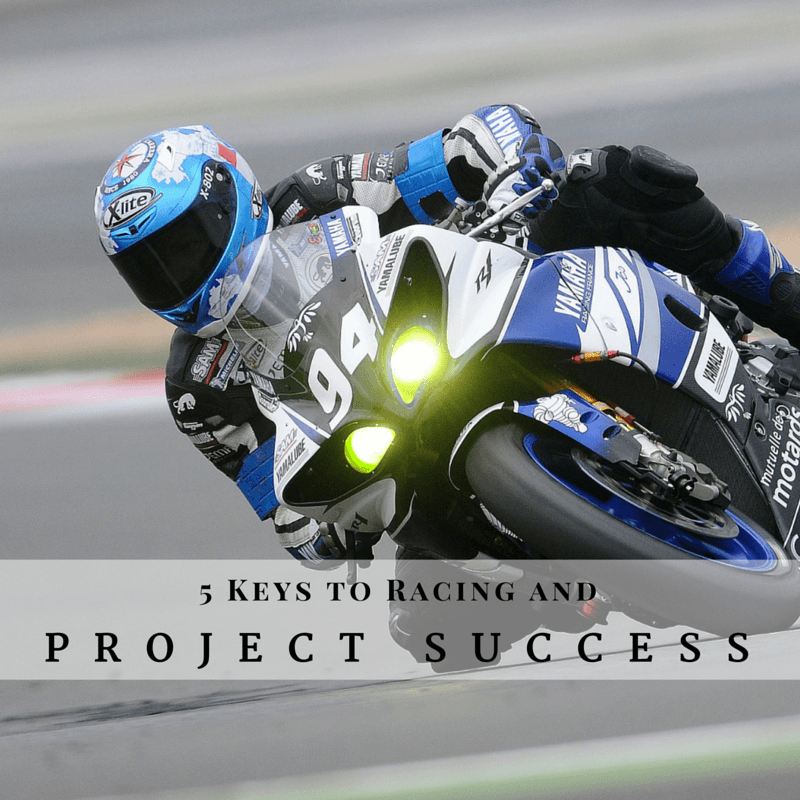
Spring is almost here in New England. The weather is warming up, which means talk has turned in our house to motorcycle season. If you will recall, my husband started racing as a rookie late last year. This year, he’s part of a race team and plans to race once a month starting in the next few weeks.
I can’t turn around without hearing talk about parts, practice and paint. It reminds me of starting off on a new project in my early days as a project manager. Previously, I wrote a post about what aspiring or new project managers could learn from motorcycle racing. Expanding upon the theme, here are five tips that are key to winning a motorcycle race that can be applied to successfully completing a project.
1. Get a good start.
Racers line up at the start, gunning their engines to get a jump off the line. They want to get ahead of the pack early, as zipping around curves and racing down straightaways is easier in a clear field than in traffic. A slow start can mean having to make up time and distance later in the race, when energy levels may be lower and unforeseen events require additional adjustment. Project managers have the ability to start out projects strong, with clear expectations and high energy. Early leads provide additional contingency to address late breaking issues and risks.
2. Follow the rules. Break the rules with intent and experience.
Rules exist for a reason. They are created and shared based on the experience of those that went before. They are meant to keep you safe. That said, playing it safe doesn’t usually win races (or successfully complete projects). As experience grows, the ability to take risks and have successful outcomes increases…the question that remains is the rider’s – or project manager’s – willingness.
3. Adjust for track conditions.
Every track is unique. So is every project. Successful racers and project managers have a baseline of resources and tools that they adjust based on specific conditions. If it’s raining, rain tires need to be put on the bike or crashing is guaranteed. When the environment changes on a project – such realization of a known risk – project managers must consider what they need to change to complete the project successfully.
4. Cut corners where it makes sense.
The shortest distance between two points is a straight line, but motorcycle racing is not like drag racing. There are twists and turns that need focus and adjustment throughout the course. Just because there’s a bend in the road, however, doesn’t mean you have to follow it. Cutting the corner and going straight through the turn can save precious time and resources on the track. Looking ahead and anticipating the most straightforward path through the twists and turns of the project can limit the amount of time and energy the team spends on work that is not critical to the end goal.
5. Reduce risk with repeatable processes.
For a racer, there are elements of any race that are a repeat of the races that came before. Processes that work are continued; those that don’t are adjusted or eliminated. One of the reasons why repeatable processes are important is so the racer can instinctively execute the repeatable tasks – such as proper body position on the motorcycle when going through a turn – and spend her time and energy looking ahead for bumps and reference points on the track. Experienced project managers reuse processes that have worked for them in the past, rather than come up with new ones for every project. It’s one less thing they have to worry about or plan for in a new project. Instead, they can focus on what’s unique for this specific effort.
Bonus – Keep 10% in the tank to address the unexpected.
Racers that push themselves to 100% of their ability level have nothing left when the unexpected happens and can quickly find themselves off the track. A smart racer runs at 90% of their limit to mitigate risk and have contingency “talent” in reserve in the event of an unforeseen circumstance during the race. Similarly, project managers need to make sure they are mentally rested and have some reserve so that the stress of risks and changes don’t push them over the edge and cause them to crash.
Like motorcycle racers, project manages must pull together their resources at the start of an effort and successfully navigate a course through twists and turns to make it to the finish line. Pushing the boundaries enough to win, without crashing, is a goal that can be achieved through repeatable process, a good start, and an occasional cut corner or two. But neither will be successful without adjusting for specific project (track) conditions and keeping a little bit of energy in reserve for when the unexpected happens.
Spring is a time of new beginnings. Whether it’s the start of a new project or a new race season, even experienced professionals should take some time to prepare. If there are techniques you use at the start of a project to increase your likelihood of success, I’d love for you to share them in the comments.








